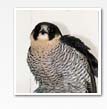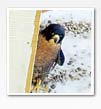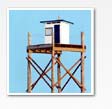|
Journal
These students from Lord Wolsely School made a huge sacrifice in order to help the Peregrines at Parkland Mews. The children had constructed a castle as part of their medieval studies and it quickly became their favourite haunt. In the spirit of generosity they decided to raffle the castle and use the funds to purchase a new lot of counters and cabinets for furbishing the new winter quarters for the Peregrine Falcons. A big thank-you kids (and teacher) from Parkland Mews.
Temperatures on the northern prairies range from summers of sub tropical humidity to polar winters with associated extreme windchills where the skin freezes in minutes.
The challenge for Parkland Mews was two fold.
The first related to, how to manage the projects animal husbandry requirements from season to season and the second; how to construct a building to cope with such climatic extremes.
After several years of experimenting with design and lots of discovery learning resulting from continuous modified improvements a new barn is in place.
Going going gone!! The following series of eight pictures depict the old building coming down. What took weeks to construct, took only hours to pull down.
Cadets from the Manitoba Home Builders Association Training Institute made a valuable in kind contribution to the construction process.
Here the cadets are compacting the base to a 97.5 degree of compaction in preparation for the thickened edge slab that forms the foundation.
Tying the steel
Pouring the concrete. Over 55 metres of concrete were poured in less than a day.
Standing the walls
Roof trusses being lifted into place.
Barn and Gemma
More barn pics
Parkland Mews produces over 4000 game birds a year including coturnix quail, bobwhite quail chukars, ring necked pheasants and waterfowl.
The birds are used as food for the Peregrines and for the Deutsch Drahthaar breeding programme.
Peregrine Falcon Breeding and Release Report 2005
Given the climatic conditions of December 2004 the Peregrines were moved from the captive breeding facility to modified enclosures in an experimental over-wintering facility. At the time, the outcome regarding possible negative impacts on future breeding could not be determined.
It is not a usual practice to move Peregrine Falcons from one enclosure to another for a sustained period of time as it is generally believed by breeders to be counter productive. Successful Peregrine Falcon Breeders in both Alberta and Saskatchewan over winter their Peregrines in unheated breeding enclosures throughout the entire year. (Wild anatum Peregrines migrate south each year to warmer climes.) Parkland Mews staff did not want to expose the birds in their care to the frigid Manitoba winter and the risk of frostbite to the falcons’ toes. The birds appeared to adjust to the move and were kept in a more humane environment, living in temperatures similar to those experienced at the southern latitudes of their annual migration.
In January 2005 a concerted effort was made to locate a general vitamin supplement, and a vitamin e supplement. Nekton products were chosen. The general vitamin supplement was added to the diet in January and February. During the month of March a combination of both the general and vitamin e supplements were used. Over this time the pair that incubated infertile eggs and fostered young in the 2004-breeding season were heard making vocalizations normally associated with courtship.
On the 23rd of March 2005 all 8 Peregrines were returned to the captive breeding facility. Breeding possibilities were limited to the pair that attempted breeding in 2004 as all other Peregrines were either failed breeders or juveniles. In a short time the potential pair was engaged in further courtship rituals although it was not possible to confirm if copulation had taken place.
By the middle of April 2005 both birds were observed incubating and it was decided not to disturb the birds in the artificial nest structure (a plastic 44 gallon drum) for fear of causing desertion.
On Monday the 22nd of May, after the known incubation period for Peregrine Falcon eggs (33 days) had elapsed, it was decided to take a brief look in the nest structure. On this first visit to inspect the nest, two chicks covered with white down believed to be a few days old were observed. The egg tooth was still prominent on both chicks. Two days later a third chick was seen and one week later the clutch size was actually four. The brevity of the first two inspections coupled with the parent brooding and being very aggressive did not allow for protracted visits.
On the 31st of May an attempt was made to band the chicks with solid bands when it was believed the chicks were 10 days old. The tarsi were too large to accommodate the C.W.S. bands and banding was delayed in favour of using USFWS bands at a later time.
Over the next 21 days visits to check on the growing youngsters were made on a weekly basis. On each visit inside the enclosure the adult female in particular became very aggressive in defence of her offspring, spreading her wings blocking the entranceway to the barrel and lunging forward with her talons while attempting to bite and inflict harm in any way she could. At this time it was concluded that the experiment in moving the birds had no negative impact on the breeding behaviour of this particular pair and is believed to be the first successful attempt of its kind. Furthermore Parkland Mews is embarking on plan to build a permanent over-wintering facility for Peregrine Falcons in its care.
On the 23rd of June two of the young males (tiercels) were removed from the breeding enclosure and transported to the release tower in order to imprint on their new surroundings. One week later the two males were returned to a new enclosure within the captive breeding facility along with their siblings another male and a female. The intent was two fold, the first being to raise the youngsters as cohorts and the second to improve the chances of survival by providing live food. Without the ability to capture moving prey the birds’ chances of survival in the wild would be even more limited. There is only a narrow window of time in the formative weeks of a young Peregrines life for developing survival skills.
The males were returned to the tower on 11th of July for more orientation before being released on the 4th of August.
An adult male was put through a fitness regime and released two weeks later while at the same time and adult female was also released but with different results.
The three males all spent time in the hack box on the tower prior to leaving and all three made their final departure from the tower platform. By way of contrast, the female was released from the gloved hand and after taking flight landed on top of the tower where she perched for some twenty minutes before making another short circuit of the Parkland Mews property alighting on top of the Resource Building. It is important to note that all Peregrines on site are kept in visual distance of the tower for most the year and in some cases all year. The process of prolonged visual exposure to the tower is a very intentional component of the hacking programme at Parkland Mews.
For the first three evenings she roosted on top of a hydro pole before beginning a pattern of roosting on the hack tower. During the first week she was constantly observed perched on property buildings, or flying from one structure to another. She would also come for food that was provided for her on a daily basis. Some of the days were windy and this helped her physical condition improve.
By the end of the second week her presence became a matter of routine and indeed when the weather was inclement she would take shelter from the rain by roosting inside the structure on the upper level of the tower.
One of the hazards Peregrine Falcons encounter is the threat posed by Great Horned Owls and the awareness of this threat remained an underlying concern as the days passed.
By the end of the third week the female was spending more and more time away from the property. At the beginning of the week the excursions were numerous but brief, however by the end of the week she would be away for up to eight hours.
The day before her final departure she flew out of sight before sunrise. She came to the tower right on dark.
She departed at first light the next day and did not return. In any event she was fit and able to catch prey on the wing, achieving a desired outcome of the release programme.
 This summer four Peregrine Falcons were released at Parkland Mews (see Recovery Plan).
This summer four Peregrine Falcons were released at Parkland Mews (see Recovery Plan).
The three males released all spent time in the hack box on the tower prior to leaving and all three made their final departure from the tower platform. By way of contrast, the female named Tess, was released from the gloved hand and after taking flight landed on top of the tower where she perched for some twenty minutes before making another short circuit of the Parkland Mews property alighting on top of the Resource Building.
For the first three evenings she roosted on top of a hydro pole before beginning a pattern of roosting on the hack tower. During the first week she was constantly observed perched on property buildings or flying from one structure to another. She would also come for food that was provided for her on a daily basis. Some of the days were windy and this helped her physical condition improve.
By the end of the second week her presence became a matter of routine and indeed when the weather was inclement she would take shelter from the rain by roosting inside the structure on the upper level of the tower.
One of the hazards Peregrine Falcons encounter is the threat posed by Great Horned Owls and the awareness of this threat remained an underlying concern as the days passed.
By the end of the third week Tess was spending more and more time away from the property. At the beginning of the week the excursions were numerous but brief, however by the end of the week she would be away for up to eight hours.
The day before her final departure she was away all day. She came to the tower right on dark and departed at first light not to return again.
Parkland Mews has exciting plans for the
future. Check out our development schedule:
2003
Construction/development of Peregrine Falcon breeding facility.
A series of 7 large flight enclosures.
Service block and office is planned for the summer and fall
of 2003.
2004
a planned building to house features connected to the Recovery
Program.
Archived Community Bulletins:
Community
Bulletin #1
In 2001 an additional female was added to the
existing nucleus of birds for use in the breeding program.
Further expansion of the Parkland Mews resources took shape
in the form of a Peregrine Falcon release tower, which was
constructed on site courtesy of Manitoba Hydro.
This last year has been even more rewarding.
In recognition of our ability to achieve the desired results,
Manitoba Conservation requested Parkland Mews to produce both
a Peregrine Falcon Recovery Plan and a Peregrine Falcon Recovery
Strategy. Manitoba Conservation also stated the requirement
that the 1999 Parkland Mews Peregrine proposal be used as
the basis of the formal recovery plan and strategy. Final
drafts of the plan and strategy were completed at the end
of 2002 and are ready for a formal printing.
The latest review concerning the status of Peregrines
across Canada indicates an increase in numbers of Peregrines
in some jurisdictions and a decrease in others. Manitoba is
one such area where the Peregrine is still in a precarious
situation. The issue is important for at least two reasons:
Firstly, while the Peregrine is showing a decline in Manitoba,
there is for the first time a recovery plan and strategy developed
in a partnership between Manitoba Conservation and Parkland
Mews which details an in province solution. This solution
is based in part on the successful recovery model employed
in other jurisdictions and the specialized skills available
through the resources of Parkland Mews. Secondly, the Peregrine
Falcon has always been regarded as a rare but indigenous nesting
species within the province and as such is worth preserving
as part of Manitoba’s natural history.
Below is our brochure saved in jpeg format for
you to download or print from your own computer. Click on
the inside and front of the brochure below to view a larger
version.

|










![]()


